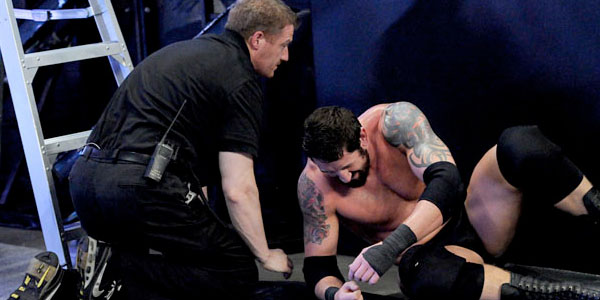5 Recent Major Injuries That Prove WWE Should Protect Their Stars Better
Is it any surprise Daniel Bryan's neck was in such a bad shape after the high risks he was taking performing every night?
 WWE.comAs Jim Ross would say, pro wrestling "ain't ballet." Even further, for as much as Triple H is known as the "Cerebral Assassin," the stress of working in wrestling as a business can certainly tax anyone's mind. Since the turn of the 21st century, pro wrestling has become a more physically active and undoubtedly mentally strenuous business than ever before. Between TLC matches, hardcore wrestling, the evolution of WWE as a corporation and the recent roll-out of the WWE Network, the industry is in a far different place than it has ever been before. That being the case, WWE's desire to present its product in an evolved manner takes a toll on not just the company itself, but as the wrestlers-turned-corporate content contributors. As matches are no longer just matches and riches reach untold heights, the desire for wrestlers (and the company itself) to do more, strive harder and possibly place themselves (and their bottom line) at greater risk is more apparent than ever before. Thus, in looking at ten examples of extraordinarily injured WWE superstars over the past fifteen years, the question must be asked. Were these injuries avoidable? And if so, why isn't WWE doing a better job of protecting their most important employees at this most critical time.
WWE.comAs Jim Ross would say, pro wrestling "ain't ballet." Even further, for as much as Triple H is known as the "Cerebral Assassin," the stress of working in wrestling as a business can certainly tax anyone's mind. Since the turn of the 21st century, pro wrestling has become a more physically active and undoubtedly mentally strenuous business than ever before. Between TLC matches, hardcore wrestling, the evolution of WWE as a corporation and the recent roll-out of the WWE Network, the industry is in a far different place than it has ever been before. That being the case, WWE's desire to present its product in an evolved manner takes a toll on not just the company itself, but as the wrestlers-turned-corporate content contributors. As matches are no longer just matches and riches reach untold heights, the desire for wrestlers (and the company itself) to do more, strive harder and possibly place themselves (and their bottom line) at greater risk is more apparent than ever before. Thus, in looking at ten examples of extraordinarily injured WWE superstars over the past fifteen years, the question must be asked. Were these injuries avoidable? And if so, why isn't WWE doing a better job of protecting their most important employees at this most critical time.
5. Wade Barrett's Separated Shoulder
 WWE.comDuring the Smackdown taping on June 23, 2014, Jack Swagger and Zeb Colter assaulted Wade Barrett to set up more heat for the Money in the Bank briefcase ladder match at the Money in the Bank Pay Per View. Wrestlers taking bumps into the dasher boards has become commonplace in WWE. However, most wrestlers willfully take an almost improbably looking flipping back bump into the boards, largely to avoid the type of injury suffered by Barrett. The blame to be placed here is two-fold. Foremost, the blame should first be placed on the person in creative or the executive that okayed such a frankly cockamamie ideal. For the average six foot tall and athletic professional wrestler, the idea of flipping into the dasher boards is pretty normal. It's the equivalent of a commonplace (and low-risk highspot, feeling akin to something out of elementary lucha libre. However, for a heavyweight grappler well over six feet tall, asking them to take such a bump - even if done so safely by merely throwing one's back heavily into the boards - is a recipe for eventual danger.
WWE.comDuring the Smackdown taping on June 23, 2014, Jack Swagger and Zeb Colter assaulted Wade Barrett to set up more heat for the Money in the Bank briefcase ladder match at the Money in the Bank Pay Per View. Wrestlers taking bumps into the dasher boards has become commonplace in WWE. However, most wrestlers willfully take an almost improbably looking flipping back bump into the boards, largely to avoid the type of injury suffered by Barrett. The blame to be placed here is two-fold. Foremost, the blame should first be placed on the person in creative or the executive that okayed such a frankly cockamamie ideal. For the average six foot tall and athletic professional wrestler, the idea of flipping into the dasher boards is pretty normal. It's the equivalent of a commonplace (and low-risk highspot, feeling akin to something out of elementary lucha libre. However, for a heavyweight grappler well over six feet tall, asking them to take such a bump - even if done so safely by merely throwing one's back heavily into the boards - is a recipe for eventual danger.